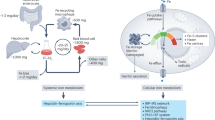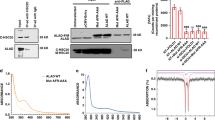Abstract
The reduction of iron is an essential step in the transferrin (Tf) cycle, which is the dominant pathway for iron uptake by red blood cell precursors. A deficiency in iron acquisition by red blood cells leads to hypochromic, microcytic anemia. Using a positional cloning strategy, we identified a gene, six-transmembrane epithelial antigen of the prostate 3 (Steap3), responsible for the iron deficiency anemia in the mouse mutant nm1054. Steap3 is expressed highly in hematopoietic tissues, colocalizes with the Tf cycle endosome and facilitates Tf-bound iron uptake. Steap3 shares homology with F420H2:NADP+ oxidoreductases found in archaea and bacteria, as well as with the yeast FRE family of metalloreductases. Overexpression of Steap3 stimulates the reduction of iron, and mice lacking Steap3 are deficient in erythroid ferrireductase activity. Taken together, these findings indicate that Steap3 is an endosomal ferrireductase required for efficient Tf-dependent iron uptake in erythroid cells.
This is a preview of subscription content, access via your institution
Access options
Subscribe to this journal
Receive 12 print issues and online access
$209.00 per year
only $17.42 per issue
Buy this article
- Purchase on Springer Link
- Instant access to full article PDF
Prices may be subject to local taxes which are calculated during checkout






Similar content being viewed by others
Accession codes
References
Ponka, P. Tissue-specific regulation of iron metabolism and heme synthesis: distinct control mechanisms in erythroid cells. Blood 89, 1–25 (1997).
Fleming, M.D. et al. Microcytic anemia mice have a mutation in Nramp2, a candidate iron transporter gene. Nat. Genet. 16, 383–386 (1997).
Fleming, M.D. et al. Nramp2 is mutated in the anemic Belgrade (b) rat: evidence of a role for Nramp2 in endosomal iron transport. Proc. Natl. Acad. Sci. USA 95, 1148–1153 (1998).
Gunshin, H. et al. Cloning and characterization of a mammalian proton-coupled metal-ion transporter. Nature 388, 482–488 (1997).
McKie, A.T. et al. An iron-regulated ferric reductase associated with the absorption of dietary iron. Science 291, 1755–1759 (2001).
Gunshin, H.S. et al. Cybrd1 (duodenal cytochrome b) is not necessary for dietary iron absorption in mice. Blood, published online 16 June 2005 (10.1182/blood-2005-02-0716).
Inman, R.S., Coughlan, M.M. & Wessling-Resnick, M. Extracellular ferrireductase activity of K562 cells is coupled to transferrin-independent iron transport. Biochemistry 33, 11850–11857 (1994).
Nunez, M-T., Gaete, V., Watkins, J.A. & Glass, J. Mobilization of iron from endocytic vesicles. The effects of acidification and reduction. J. Biol. Chem. 265, 6688–6692 (1990).
Dhungana, S. et al. Redox properties of human transferrin bound to its receptor. Biochemistry 43, 205–209 (2004).
Ohgami, R.S. et al. nm1054, a spontaneous, recessive, hypochromic, microcytic anemia mutation in the mouse. Blood, published online 30 June 2005 (10.1182/blood-2005-01-0379).
Porkka, K.P., Nupponen, N.N., Tammela, T.L., Vessella, R.L. & Visakorpi, T. Human pHyde is not a classical tumor suppressor gene in prostate cancer. Int. J. Cancer 106, 729–735 (2003).
Steiner, M.S., Zhang, X., Wang, Y. & Lu, Y. Growth inhibition of prostate cancer by an adenovirus expressing a novel tumor suppressor gene, pHyde. Cancer Res. 60, 4419–4425 (2000).
Zhang, X., Steiner, M.S., Rinaldy, A. & Lu, Y. Apoptosis induction in prostate cancer cells by a novel gene product, pHyde, involves caspase-3. Oncogene 20, 5982–5990 (2001).
Amzallag, N. et al. TSAP6 facilitates the secretion of translationally controlled tumor protein/histamine-releasing factor via a nonclassical pathway. J. Biol. Chem. 279, 46104–46112 (2004).
Passer, B.J. et al. The p53-inducible TSAP6 gene product regulates apoptosis and the cell cycle and interacts with Nix and the Myt1 kinase. Proc. Natl. Acad. Sci. USA 100, 2284–2289 (2003).
Labbe, R., Vreman, H. & Stevenson, D. Zinc protoporhyrin: A metabolite with a mission. Clin. Chem. 45, 2060–2072 (1999).
Bateman, A. et al. The Pfam protein families database. Nucleic Acids Res. 32, D138–D141 (2004).
Sanchez-Pulido, L., Rojas, A.M., Valencia, A., Martinez, A.C. & Andrade, M.A. ACRATA: a novel electron transfer domain associated to apoptosis and cancer. BMC Cancer 4, 98 (2004).
Warkentin, E. et al. Structures of F420H2:NADP+ oxidoreductase with and without its substrates bound. EMBO J. 20, 6561–6569 (2001).
Moldes, M. et al. Tumor necrosis factor-alpha-induced adipose-related protein (TIARP), a cell-surface protein that is highly induced by tumor necrosis factor-alpha and adipose conversion. J. Biol. Chem. 276, 33938–33946 (2001).
Porkka, K.P., Helenius, M.A. & Visakorpi, T. Cloning and characterization of a novel six-transmembrane protein STEAP2, expressed in normal and malignant prostate. Lab. Invest. 82, 1573–1582 (2002).
Shatwell, K.P., Dancis, A., Cross, A.R., Klausner, R.D. & Segal, A.W. The FRE1 ferric reductase of Saccharomyces cerevisiae is a cytochrome b similar to that of NADPH oxidase. J. Biol. Chem. 271, 14240–14244 (1996).
Finegold, A.A., Shatwell, K.P., Segal, A.W., Klausner, R.D. & Dancis, A. Intramembrane bis-heme motif for transmembrane electron transport conserved in a yeast iron reductase and the human NADPH oxidase. J. Biol. Chem. 271, 31021–31024 (1996).
Hubert, R.S. et al. STEAP: a prostate-specific cell-surface antigen highly expressed in human prostate tumors. Proc. Natl. Acad. Sci. USA 96, 14523–14528 (1999).
Yang, D., Holt, G.E., Velders, M.P., Kwon, E.D. & Kast, W.M. Murine six-transmembrane epithelial antigen of the prostate, prostate stem cell antigen, and prostate-specific membrane antigen: prostate-specific cell-surface antigens highly expressed in prostate cancer of transgenic adenocarcinoma mouse prostate mice. Cancer Res. 61, 5857–5860 (2001).
Goldman, G.L. & Thornton, J.I. A new trace ferrous metal detection reagent. J. Forensic Sci. 21, 625–628 (1976).
Lesuisse, E., Casteras-Simon, M. & Labbe, P. Evidence for the Saccharomyces cerevisiae ferrireductase system being a multicomponent electron transport chain. J. Biol. Chem. 271, 13578–13583 (1996).
Ross, J.S. et al. Correlation of primary tumor prostate-specific membrane antigen expression with disease recurrence in prostate cancer. Clin. Cancer Res. 9, 6357–6362 (2003).
Su, M.A., Trenor, C.C., Fleming, J.C., Fleming, M.D. & Andrews, N.C. The G185R mutation disrupts function of iron transporter Nramp2. Blood 92, 2157–2163 (1998).
Schwaller, J. et al. Transformation of hematopoietic cell lines to growth-factor independence and induction of a fatal myelo- and lymphoproliferative disease in mice by retrovirally transduced TEL/JAK2 fusion genes. EMBO J. 17, 5321–5333 (1998).
Acknowledgements
We thank L. Lee, H. Gunshin, N. Andrews, E. Neufeld and members of the laboratories of N. Andrews and E. Neufeld for ongoing support and criticism and N. Stokes and T. Borjeson for technical support. This work was supported by the Pew Biomedical Scholars Program (M.D.F) and grants from the US National Institutes of Health (M.D.F. and J.E.B.). Transgenic core facilities were supported by a grant from the US National Institutes of Health.
Author information
Authors and Affiliations
Corresponding author
Ethics declarations
Competing interests
The authors declare no competing financial interests.
Supplementary information
Supplementary Fig. 1
Recombination map of the nm1054 locus. (PDF 96 kb)
Supplementary Fig. 2
Steap3 gene targeting strategy. (PDF 141 kb)
Supplementary Fig. 3
Multiple sequence alignment of the Steaps. (PDF 94 kb)
Supplementary Table 1
Hematological data in Steap3 mutant and control mice. (PDF 61 kb)
Supplementary Table 2
Iron status of 8-week-old Steap3 mutant and control mice. (PDF 51 kb)
Supplementary Table 3
Quantitative real-time PCR primers. (PDF 28 kb)
Rights and permissions
About this article
Cite this article
Ohgami, R., Campagna, D., Greer, E. et al. Identification of a ferrireductase required for efficient transferrin-dependent iron uptake in erythroid cells. Nat Genet 37, 1264–1269 (2005). https://doi.org/10.1038/ng1658
Received:
Accepted:
Published:
Issue Date:
DOI: https://doi.org/10.1038/ng1658
This article is cited by
-
Ferroptosis: underlying mechanisms and involvement in neurodegenerative diseases
Apoptosis (2024)
-
Ferroptosis regulation through Nrf2 and implications for neurodegenerative diseases
Archives of Toxicology (2024)
-
Enhanced oxidative phosphorylation, re-organized intracellular signaling, and epigenetic de-silencing as revealed by oligodendrocyte translatome analysis after contusive spinal cord injury
Scientific Reports (2023)
-
Targeting ferroptosis opens new avenues for the development of novel therapeutics
Signal Transduction and Targeted Therapy (2023)
-
Comparative transcriptome analysis of eyes reveals the adaptive mechanism of mantis shrimp (oratosquilla oratoria) induced by a dark environment
Genetica (2023)



